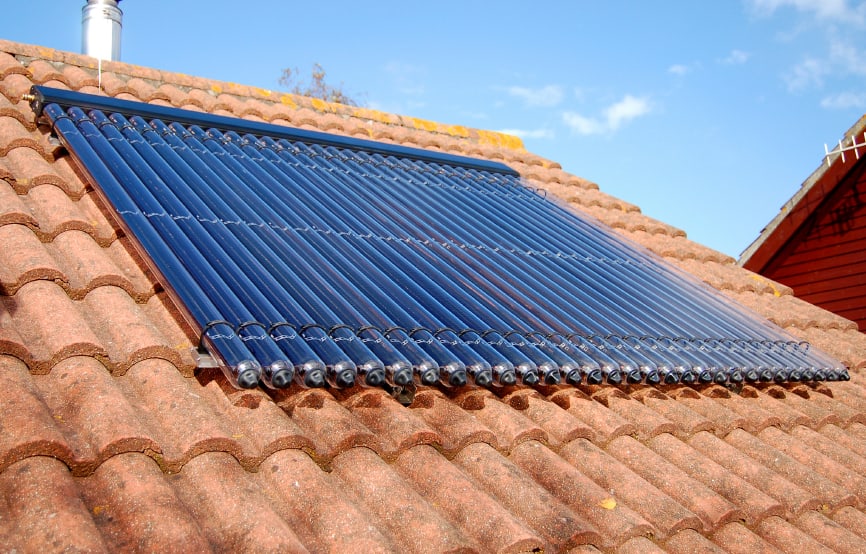Solar water heating
What is solar water heating?
Solar water heating, often referred to as ‘solar thermal’, involves using solar panels to absorb the heat of the sun and transfer it to the water you use in the home. On warm summer days a solar thermal system could provide all of your hot water. During the winter the output will be considerably less.
An alternative to solar water heating is solar photovoltaic panels plus a solar diverter. A solar diverter is a device to use electricity generated by photovoltaic solar panels to heat water in your cylinder. The best option for you will depend on a number of factors such as your hot water usage and the amount of roof space you have available. An installer will be able to discuss this with you.
How does solar water heating work?
Solar thermal technology works alongside conventional water heating systems. Heat absorbed by the panels is used to pre-heat water that is either fed into a hot water storage cylinder or directly into a combination boiler. This reduces the amount of fuel needed to bring the hot water up to a useable temperature, saving money on heating bills and reducing carbon emissions.
In a ‘direct’ or ‘open-loop’ system the water heated in the solar panels goes directly into the domestic hot water cylinder. These systems are very rarely used in the UK because of the risk of both freezing and overheating.
Most solar systems are ‘indirect’ so the liquid in the panels is not the same as what comes out of the taps. Instead, it is a mixture of water and antifreeze. The heat it absorbs from the sun is transferred to the water in the hot water cylinder through a copper coil.
There are two main types of solar collector. Flat plate collectors are dark, box like structures which contain a series of pipes running horizontally and vertically inside them.
Evacuated tube systems are a series of glass tubes (below). The vacuum created within the tubes minimises heat loss from the solar collector, particularly in colder conditions. No liquid passes through the tubes themselves. Instead, the heat is transferred through a heat-exchanger which is fixed to the top of the tubes. Evacuated tube systems tend to be more efficient but are also more expensive.

Is your home suitable for solar water heating?
There’s a couple of practical things you need to consider before investing in a solar water heating system.
- The space where you are putting your panels should face predominantly south. Due-south is ideal but anywhere between south-east and south-west is also likely to be suitable.
- You’ll need between 2 and 5m2 of roof space. The available roof space needs to have as little shading as possible from buildings, chimneys or trees. Any shading will reduce the output of the solar panels. Panels can also be fitted on a frame on a flat roof.
- If you have a hot water storage cylinder, it’s likely a solar thermal system can be installed.
- Combination or ‘combi’ boilers do not have separate hot water cylinders. They therefore need to be be able to accept pre-heated water directly into the boiler. If your combi boiler can’t do this, you will need to install a separate hot water cylinder as part of your solar thermal system.
In terms of planning permission, solar panels are usually classed as a permitted development, but some restrictions still apply (especially in conservation areas or on listed buildings) so check before proceeding.
What about costs?
How much does solar water heating cost? Most domestic solar water heating systems cost roughly £6,000 depending on the size, type and number of panels. Installers will offer different systems, so it’s worth doing the research and getting quotes from at least three suppliers. Make sure that both system and installer are registered with the Microgeneration Certification Scheme and use an installer who has signed up to the Renewable Energy Consumer Code.
Solar hot water systems require some regular maintenance, although costs are fairly minimal. You can perform a yearly check yourself on the condition of the panels – the installer should leave you with a written list of maintenance checks that you can do, and actions such as topping up antifreeze. Some installers may offer an annual service (costing around £100), but it’s recommended to have a professional service every three to five years.
How much could you save?
A well-installed and properly used solar hot water system will save money. The Energy Saving Trust estimate savings in the region of £110-£210 a year for a 4m2 system, depending on factors like the size of the household, the type of heating being replaced and the orientation of the panels themselves.




